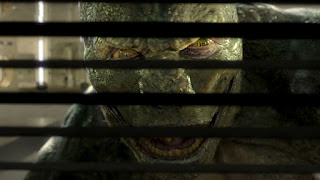Native 3D:
Like Prometheus, The Amazing Spider-Man was filmed using Red Epic cameras, in 'native' 3D. In 2012, we've seen a string of high-quality post-production conversions, and we were hoping that Spidey webslinging in three-dimensions would blow them all out of the water. Much was made in the lead-up to the film's release of how much real-world filming was completed (see the photo nearby as an example of leaked images from the film's shoot), so in theory we were due to see the most vivid superhero scenes yet seen in 3D. Indeed, whenever Spider-Man has his suit on, the shots are busy, shot from interesting angles and broad in their scope. Bizarrely though, if Peter Parker's at school or home, the 3D footage is some of the most boring we've ever seen. Considering how much Peter Parker features in this film, we were left wondering why they filmed in native 3D at all.
Does the 3D 'pop'?
Incredibly rarely. The odd holographic image in the Oscorp Labs reaches beyond the screen, and every once in a while Spidey's legs break the artificial 'wall' of the theatre's screen, but these are the exceptions to the rule. In comparison to, say, Men In Black 3's 3D, which felt like there was no plane of depth left unexplored, The Amazing Spider-Man's action takes place well beyond your seat. Until the last shot, you're not going to see webs fly out at the audience, or Lizard tails flaying about over the front row's seats. Check out the image nearby as a wasted example, where a key scene involves the Lizard... behind a shuttered door. If it were us making the film, we'd have had the Lizard stalking his prey in a way where you were terrified his head would jump out at you without warning. Instead, in this scene, he was overtly restricted from doing so! Boring.
How's the depth of the 3D?
As mentioned above, when Spider-Man's swinging like a pendulum over the New York city skyline, the depth is fantastic. It's the most vivid depiction of Manhattan we've ever seen on the screen. Much of the action is shot at night-time though, so it's hard to visualise the gaps between individual skyscrapers. Instead, we see the differences of city blocks, or long avenues that culminate in a gigantic building like Oscorp's tower. Mostly though, the film is set in a fairly bland looking suburbia, and the frame is focused on the foreground and midground, with an out of focus background. This means that depth is restricted to the first couple of metres, with a universal background of blurriness that lacks any sort of visual interest (or reason to have glasses on). In comparison to the deep-focus of Avatar, or the intensely layered shots of Hugo, Spider-Man's interior scenes utterly failed to justify the extra admission fees that 3D cost. Check out the image nearby as an example of a wasted shot composition: two characters in the foreground and a blurred background.
 Did it make sense to add 3D to this film?
Did it make sense to add 3D to this film?
Sure. On paper, it sounds like a done deal. Spider-Man is the 'daylight hero', wearing bright blue and red colours, framed against brownstone buildings, hundreds of feet in the air above the world's most dynamic city. For some bizarre reason though, the studio (I'm loathe to blame the film's director) set the majority of the film at night-time, darkened the suit, and adjusted the physics to be so realistic that Spider-Man needs the assistance of the city's engineer-folk to swing a few metres at a time. So, if brightness and depth are the priorities, they compromised both in favour of a "more realistic" Spider-Man that feels untrue to the comic's roots.
If we had to archive one version, should we save the 2D or the 3D?
The 2D. Without a doubt. Bear in mind that we here at 3Defence are massive fans of the Spider-Man books, the 3D technique, native 3D films, director Marc Webb, and many of the key creatives who made The Amazing Spider-Man. So when we say the 2D version of this film is the only one to keep, we mean it, and it hurts to say it. Bummer!





No comments:
Post a Comment